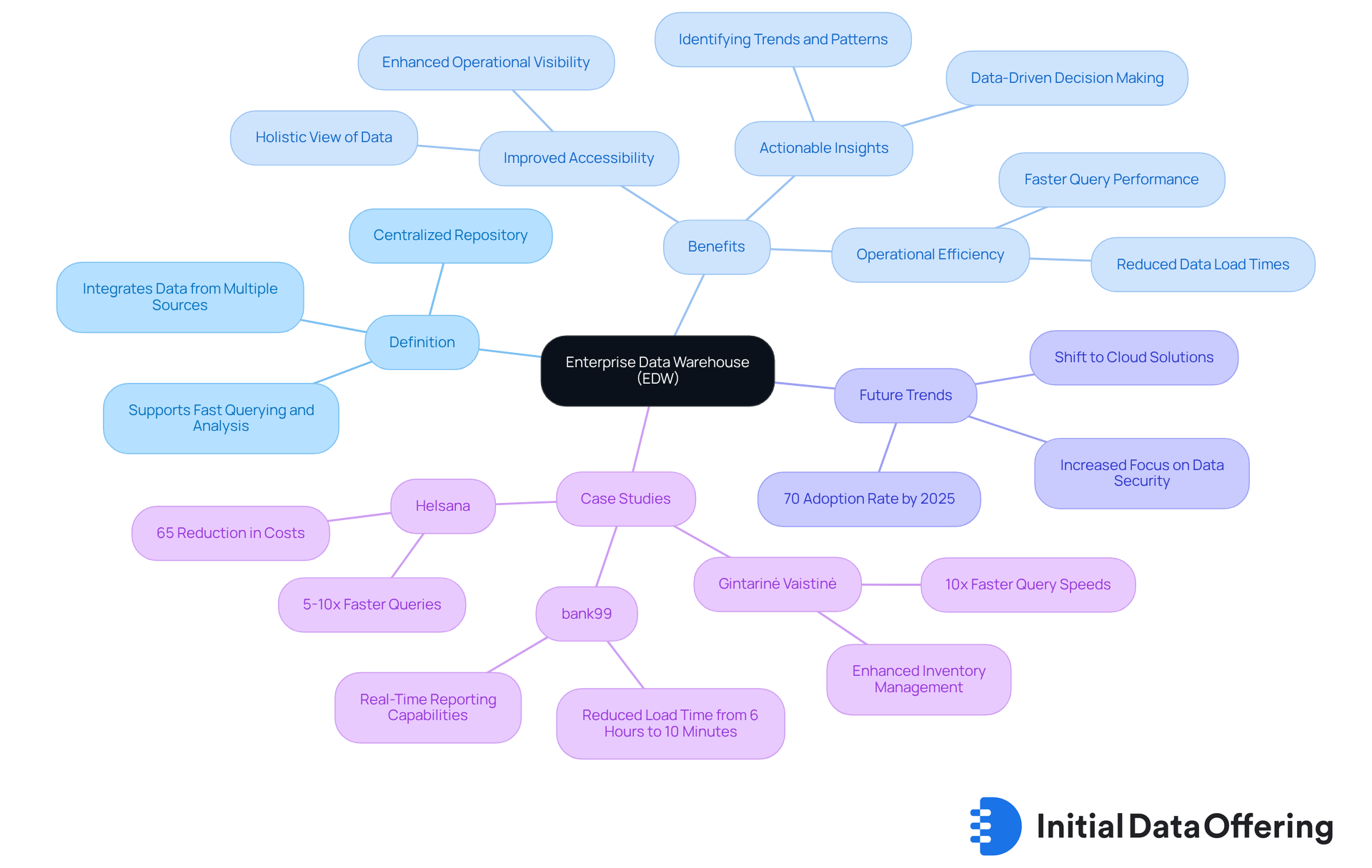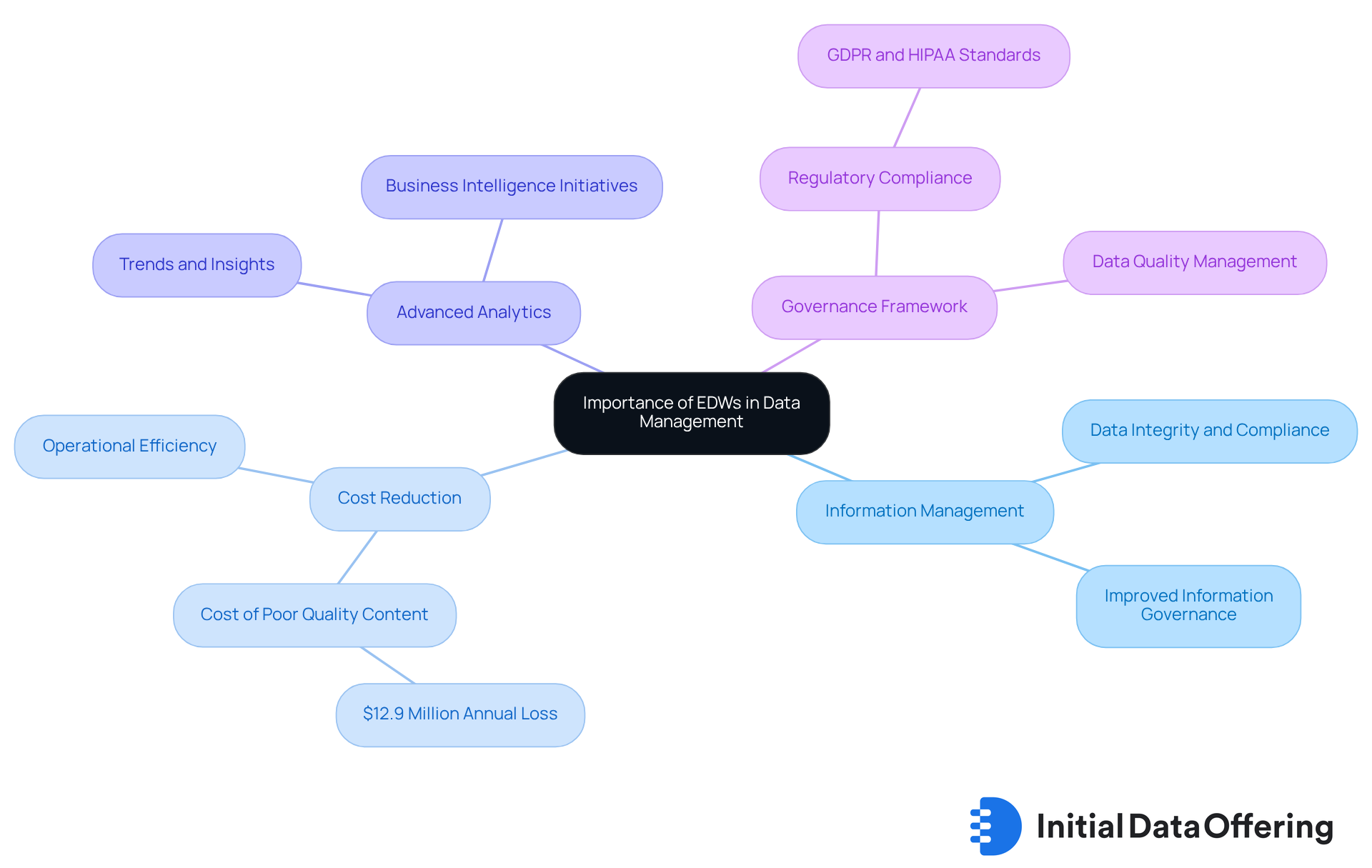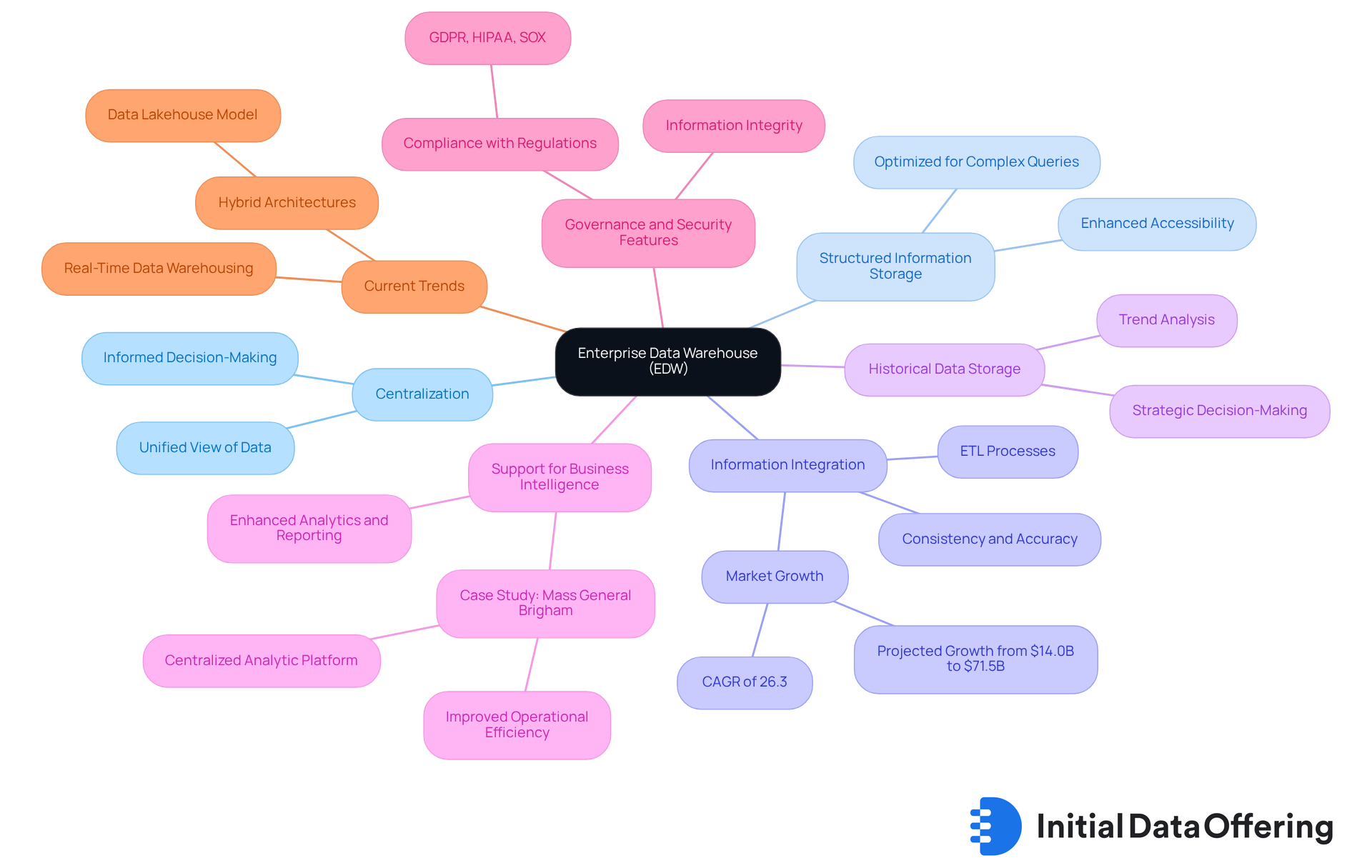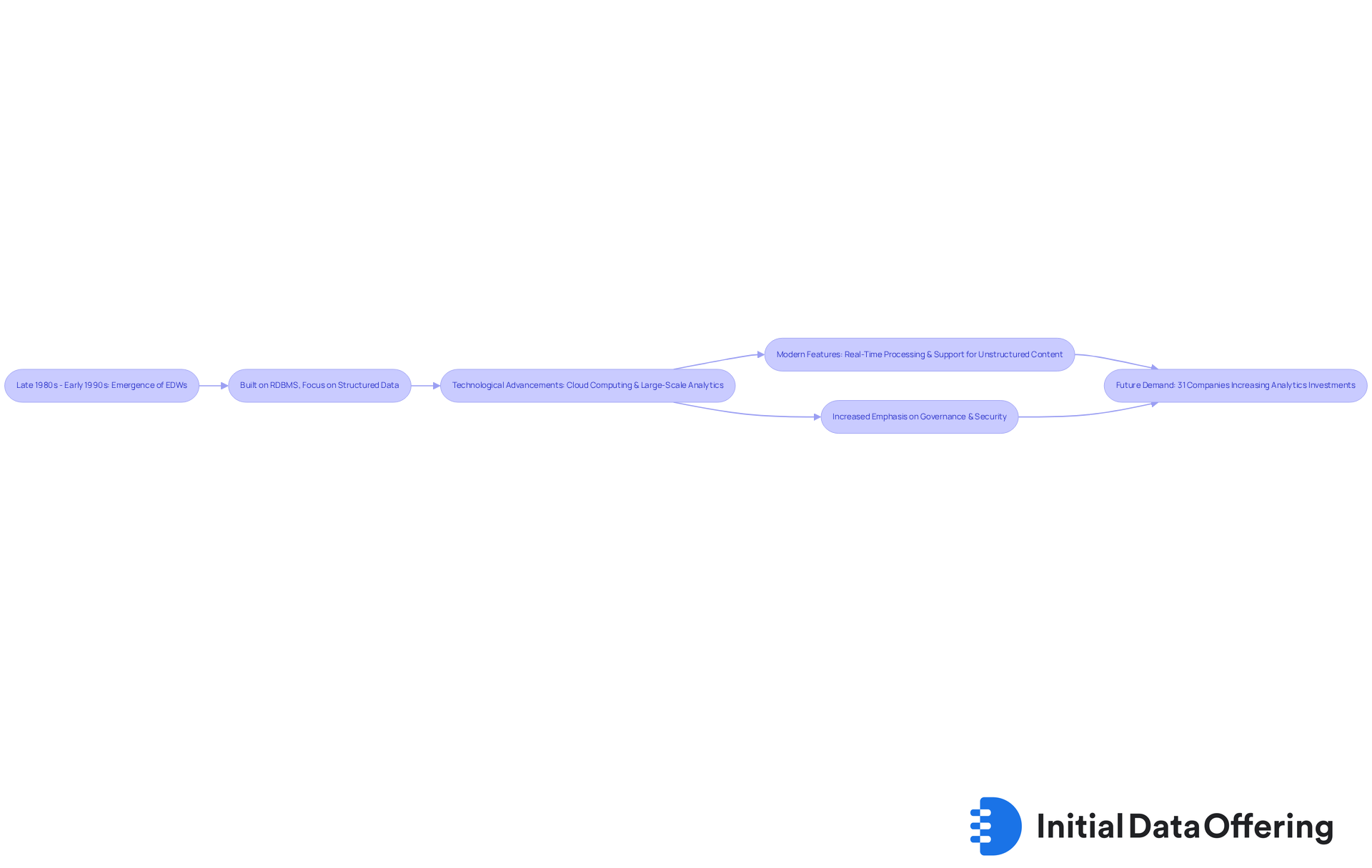What is an EDW? Understanding Its Role and Key Features

What is an EDW? Understanding Its Role and Key Features
Overview
An Enterprise Data Warehouse (EDW) serves as a centralized repository that organizes and manages substantial volumes of data from diverse sources. This structure facilitates analysis and reporting, empowering organizations to make informed decisions.
The advantages of implementing an EDW are evident in numerous case studies, where organizations have significantly enhanced their operational efficiency and data accessibility. These improvements underscore the critical role of EDWs in modern information management.
How might your organization benefit from adopting an EDW? By streamlining data processes, an EDW not only improves accessibility but also supports strategic decision-making, ultimately leading to better business outcomes.
Introduction
An Enterprise Data Warehouse (EDW) serves as a cornerstone in data management, acting as a centralized hub that integrates vast amounts of information from various sources within an organization.
As businesses increasingly rely on data-driven insights for strategic decision-making, understanding the role and features of EDWs is paramount.
The features of an EDW include:
- Its ability to consolidate data from disparate sources, ensuring accuracy and consistency.
- Improved data accessibility.
- Enhanced reporting capabilities.
Ultimately, these benefits empower organizations to make informed decisions that enhance operational efficiency.
However, with the rapid evolution of technology and the growing complexity of data landscapes, how can organizations effectively harness the full potential of EDWs?
This question invites consideration of strategies that can optimize the use of EDWs to boost decision-making capabilities.
Define Enterprise Data Warehouse (EDW)
An EDW serves as a centralized repository that efficiently stores and manages vast amounts of information from diverse sources within an organization. This system combines organized information from various operational systems, facilitating extensive reporting and analysis, thereby acting as a unified source of truth. The consolidation of data not only improves accessibility but also enables stakeholders to quickly obtain actionable insights.
By 2025, it is anticipated that 70% of enterprises will utilize EDW to enhance their information management capabilities. This trend indicates a growing acknowledgment of the significance of EDW in enabling decision-making based on insights. For example, Gintarinė Vaistinė, a pharmacy chain, achieved a tenfold increase in query speed and enhanced operational visibility across over 240 stores through the implementation of an EDW. Similarly, bank99 reduced its daily information load time from six hours to approximately ten minutes after transitioning to a cloud-based EDW. These cases showcase the transformative effect of such systems on organizational efficiency.
As organizations increasingly recognize the importance of information in strategic planning, the implementation of enterprise data repositories is expected to rise. Many firms are looking to leverage the potential of EDW for enhanced insights and operational effectiveness. According to ScienceSoft, the distinction between an enterprise data warehouse and a repository of information lies in the scope, underscoring the essential role that EDWs play in contemporary information management.

Contextualize the Importance of EDWs in Data Management
EDW, or Enterprise Information Warehouses, are essential for effective information management, providing a structured framework for both storage and retrieval. By integrating diverse information sources, these warehouses enhance information governance, compliance, and security—key components in today’s information-centric landscape.
For instance, institutions utilizing enterprise information warehouses have experienced a significant reduction in inconsistencies. Studies indicate that poor-quality content can cost businesses approximately $12.9 million annually. Furthermore, enterprise data warehouses (EDW) facilitate advanced analytics and business intelligence initiatives, enabling organizations to identify trends, improve operations, and enhance customer experiences.
As reliance on information for strategic decision-making intensifies, the role of enterprise storage systems in fostering a robust EDW governance framework becomes increasingly vital. In fact, 84% of enterprises acknowledge the need for a solid information foundation, which enterprise data stores provide by ensuring data integrity and compliance with regulatory standards.
By leveraging enterprise storage systems, organizations not only optimize their information processes but also bolster their ability to respond to market dynamics and operational shifts in real-time, underscoring the importance of these systems in supporting informed decision-making.

Explore Key Characteristics and Components of EDWs
Key characteristics of an Enterprise Data Warehouse (EDW) include:
-
Centralization: EDWs aggregate data from diverse sources, providing a unified view of organizational data. This centralization is crucial for comprehensive analysis within an EDW, allowing organizations to make informed decisions based on a complete data landscape.
-
Structured Information Storage: Optimized for structured information, these systems facilitate complex queries and analyses. This optimization enhances accessibility and usability, making it easier for users to derive insights from the data.
-
Information Integration: Utilizing Extract, Transform, Load (ETL) processes, information integration is ensured by EDW from various systems. This integration promotes consistency and accuracy throughout the entity. Notably, the EDW market is anticipated to expand from $14.0 billion in 2023 to $71.5 billion by 2030, reflecting a compound annual growth rate (CAGR) of 26.3%. This growth indicates the increasing dependence on efficient information integration in EDW business environments.
-
Historical Data Storage: By preserving historical data, data warehouses enable entities to analyze trends over time. This capability supports strategic decision-making and forecasting, allowing organizations to anticipate future challenges and opportunities.
-
Support for Business Intelligence: Designed to enhance analytics and reporting capabilities, EDW empowers users to generate insights and make informed decisions. For instance, organizations such as Mass General Brigham have successfully established data warehouses, leading to improved operational efficiency and enhanced customer experiences through a centralized analytic platform.
-
Governance and Security Features: Effective governance and security measures are critical in enterprise data warehouses. These features ensure compliance with regulations and maintain information integrity, which is essential for building trust in the records.
-
Current Trends: The changing environment of information storage features trends such as hybrid architectures, like the 'Data Lakehouse.' These architectures merge the adaptability of modern storage solutions with the organized method of enterprise data warehouses, further improving their functionalities.
These traits underscore the crucial role of enterprise information repositories in assisting entities to utilize their resources efficiently. Ultimately, this leads to improved results and informed decision-making.

Trace the Evolution of EDWs in Data Management
The concept of the Enterprise Data Warehouse (EDW) emerged in the late 1980s and early 1990s, driven by organizations' need to manage increasing volumes of data. Initially, these warehouses were built on relational database management systems (RDBMS), focusing primarily on structured data storage and reporting. However, technological advancements, such as cloud computing and large-scale analytics, have transformed data warehouses into more flexible and scalable EDW solutions.
Modern EDWs now offer features like real-time data processing, support for unstructured content, and integration with advanced analytics tools. This evolution reflects the growing complexity of data management and the necessity for organizations to adapt to a rapidly changing information landscape. As businesses increasingly adopt cloud-based solutions, there is a heightened emphasis on governance and security within EDW to ensure data quality and regulatory compliance.
Furthermore, with 31% of companies planning to significantly increase their analytics investments, the demand for contemporary EDWs is on the rise. Tools like Apache NiFi and Talend have significantly enhanced the development of ETL processes, enabling organizations to manage data more efficiently. Notably, the cloud storage market is projected to reach $10.42 billion by 2026, highlighting the broader shift towards cloud-based solutions in EDW (Enterprise Data Warehousing). How can your organization leverage these advancements to optimize its data management strategies?

Conclusion
An Enterprise Data Warehouse (EDW) serves as a crucial backbone for organizations seeking to manage and analyze vast amounts of data efficiently. By centralizing information from diverse sources, EDWs enhance data accessibility and empower stakeholders to make informed decisions based on reliable insights. As the reliance on data-driven decision-making continues to grow, adopting EDWs is increasingly vital for organizations aiming to remain competitive and responsive in their respective markets.
Key characteristics of EDWs include:
- Their ability to integrate information
- Support for business intelligence
- Ensuring data governance and security
Real-world examples illustrate the transformative impact of EDWs, showcasing significant improvements in operational efficiency and decision-making capabilities. The evolution of EDWs also reflects the changing landscape of data management, with advancements in technology paving the way for more flexible and scalable solutions.
In light of these insights, organizations must prioritize the implementation and optimization of EDWs to harness the full potential of their data. As the market for enterprise data warehouses expands, embracing these systems will streamline information management processes and foster a culture of informed decision-making. The future of data management lies in leveraging the capabilities of EDWs, ensuring that organizations can adapt to the ever-evolving demands of the information age.
Frequently Asked Questions
What is an Enterprise Data Warehouse (EDW)?
An EDW is a centralized repository that stores and manages large amounts of information from various sources within an organization, facilitating reporting and analysis as a unified source of truth.
How does an EDW improve data accessibility?
By consolidating data from different operational systems, an EDW enhances accessibility, allowing stakeholders to quickly obtain actionable insights.
What is the projected adoption rate of EDWs by 2025?
It is anticipated that 70% of enterprises will utilize EDWs by 2025 to improve their information management capabilities.
Can you provide examples of organizations that benefited from implementing an EDW?
Gintarinė Vaistinė saw a tenfold increase in query speed and improved operational visibility across 240 stores, while bank99 reduced its daily information load time from six hours to about ten minutes after transitioning to a cloud-based EDW.
Why are organizations increasingly implementing EDWs?
Organizations recognize the importance of information in strategic planning and are looking to leverage EDWs for enhanced insights and operational effectiveness.
What distinguishes an EDW from a regular information repository?
The distinction lies in the scope; EDWs play a crucial role in contemporary information management by providing a comprehensive framework for data analysis and reporting.